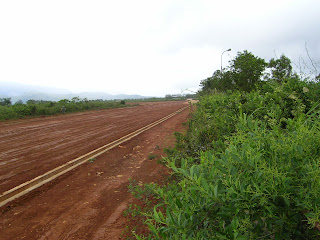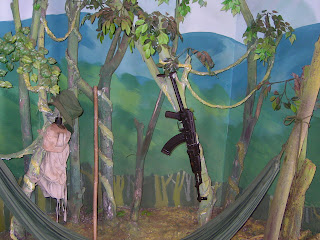The Google Hotel, Hue, (South) Vietnam
Currently sitting in the hotel lobby in Hue (pronounced ‘Hu-way’), just South of what was the DMZ (De-Militarized Zone) marking the old border between North and South Vietnam.
On Saturday night a couple of the Aussies and I went along to a big ex-pat bar in a very smart block of ‘condo’s’, just next to the ‘Hanoi Hilton’ museum, to watch the horror that was the England Ireland game. Oh well, at least we’ve got an economy.
In the morning, I crawled out of bed to go and see the mausoleum and corpse of Ho Chi Minh himself which was somewhat surreal. ‘Uncle Ho’ founded the Vietnamese Communist Party in 1930 and during the Japanese occupation of World War 2 they were the most organised resistance movement against the Japs, inevitably with Western support. In 1945 after the defeat of the Japanese the French attempted to re-take control of Vietnam. However, this ultimately lead to the humiliation at Dien Bien Phu in 1954 and the subsequent partition of the country, at the Geneva Conference, between the Communist North, under ‘Uncle Ho’ in Hanoi and the pro-Western South under the government in Saigon.
As we walked through Hanoi towards the mausoleum there were various groups of soldiers in green uniforms badly attempting to goose-step around with AK rifles (not that I should ever criticise anybody else’s drill!). I thought that taking a photo of them might not be too bright, but they didn’t look too different to the old NVA (North Vietnamese Army). The Mausoleum was a big, ostentatious, concrete box with the inevitable vast communist flag, yellow star on red background, flying from it. We joined the procession to file through, and I was amazed at just how much this one individual man is revered. There were more uniformed people at the mausoleum itself, this time in white, goose-stepping up and down with ancient Soviet SKS rifles- as well as American Motorola ‘Air Wave’ personal radios. They also took all cameras off us and ensured that everybody filed through in 2’s, and that there was no talking, or even hands in pockets. Uncle Ho himself wasn’t looking too well in his glass cabinet, but the rumour, which I believe, is that there is rather more Madame Tussaude’s type work in there than any actual human DNA.
After spending the day strolling around Hanoi, a group of us got the overnight bus from Hanoi down to Hue. This bus was definitely a step up from the one from Laos as it was just 3 rows of bunk beds the length of the bus and I could actually lie down! We arrived at the Google Hotel in Hue and immediately checked in- it’s a 4 Star level hotel, for US$5 a night, happy days.
Yesterday my Aussie travelling companion, who is also interested in military history (and rugby), and I went for a ‘battlefield tour’ along ‘Route 9’ (Hmmm, does that sound French or Vietnamese... or possibly US military legacy?) to see the old ‘DMZ’, the Ho Chi Minh Trail and the old Combat Base (what we would now call a Forward Operating Base or F.O.B.) at Khe Sahn (pronounced ‘Kay Sarn’), which was the scene of the biggest and most famous battle of the war in 1968. We were on a bus trip with a local guide who claimed he’d been 14 in ’68, and that he ‘had friends who were in the Viet Cong’ which was why he knew so much about them. Unlike the US Marines at Khe Sahn, ‘Charlie’ (VC in the phonetic alphabet is Victor Charlie, hence ‘Charlie’) did not have a minimum enlistment age... Needless to say, I ended up giving a bit of a history lesson to some of the yanks and Brits on the bus who knew nothing.
The withdrawal of the French in ’54 was meant to be followed by a couple of years of partition, with free transition between North and South, then ‘democratic’ elections across the country would be held in 1956. However in 1955 the Prime Minister of the South, Diem, announced that since the South did not recognise the Geneva Conferences, they were not bound by them and they would not participate in the elections. He subsequently declared South Vietnam as the Republic Of Vietnam (ROV) with himself as President.
In January 1959 the North Vietnamese began to pump guerrillas and weapons into the South along the ‘Ho Chi Minh Trail’ which was just a series of tracks through the jungle to undermine the ROV. The American military involvement began discreetly under JFK after he took over in January 1961, with the deployment of Green Beret ‘advisors’ to the South Vietnamese Army the ARVN (known to the yanks as ‘Marven’). In the ‘Gulf of Tonkin Incident’ in August 1964 American warships were allegedly engaged by North Vietnamese vessels, and returned fire- although there’s an element of suspicion that this was a bit ‘Tony Blair-esque’. This ‘incident’ lead to airstrikes by the Americans on North Vietnam from bases established in South Vietnam. A year later, in March 1965, after several attacks on the air bases, 3,500 US Marines were deployed to South Vietnam to basically provide ‘Force Protection’ for the planes. However, by December this number had increased to 200,000 men under General Westmoreland. During the period of this escalation in numbers the ARVN suffered a series of heavy defeats by the communists so Westmoreland pushed President Johnson to allow him to take a more offensive approach, and to sideline the ARVN which is ultimately what happened.
Every year during the festival of Tet, the Chinese New Year, there was an informal truce between North and South, which both sides were keen to uphold. Khe Sanh Combat Base was located on the old Ho Chi Minh Trail (before this moved into Laos between ’65 and ’72), about 20 K’s from the Laos border, and was garrisoned by elements of the US Marine Corps, as well as Green Beret types. On January 21st 1968, just before the Tet holiday, the North Vietnamese Army launched a sustained bombardment and assault on the Marines at Khe Sahn, which resulted in the Marines being effectively besieged up there for 77 days. The ground around Khe Sahn is extremely steep, and covered in thick vegetation and resupplying the Marines along the ground proved impossible so the US pilots were forced to brave ferocious fire to land their C130 Hercules aircraft on the tiny landing strip to bring in reinforcements as well as supplies of food, ammunition etc.
Figure 6: Captured American wpns at Khe Sahn, LAW 66, M79 grenade Launcher, Claymore mine, M16 rifle
For those of us who have flown by C130 into such joyous corners of the world as Basra, Kandahar, Kabul etc, the vertical dive done on approach, prior to pulling up at the last minute, to present as minimum a target as possible for ‘Haj’ to shoot at, is known to the pilots as the ‘Khe Sahn Dive’. Having done 3 in 1 day, on an empty stomach, in my enthusiasm to get back to London from Afghanistan for R&R, the novelty does wear off!!
The principle effect of Khe Sahn was that it meant that America had to deploy more troops there prior to the Tet Holiday. This had been anticipated by the Communists as they launched their surprise ‘Tet Offensive’ on the 31st of January, when they simultaneously attacked over 100 locations around South Vietnam including the US Embassy in Saigon, and General Westmoreland’s HQ. The heaviest fighting of Tet was actually in the Citadel in Hue. While the Tet Offensive ultimately ended in the slaughter of the communist participants, it is alleged to have been the turning point for a previously supportive American public.
The Siege of Khe Sahn was eventually lifted on the 8th of April when Marine Infantry and Engineer units, who had spent 8 days moving West along Route 9, with support from the soldiers of the helicopter-borne 1st Air Cav (the black horse on a yellow shield shoulder patch) who provided over-watch from the high ground along the route, linked up with the defending Marines at the Combat Base.
As well as visiting Khe Sahn itself, and the small museum there, we saw Combat Outpost Rock Pile, which was an 8 man Observation Post on top of a prominent hill from where the lucky individuals inside watched for VC activity in the area and, where appropriate, called in fire. There was a big, ugly memorial to all the Vietnamese ‘messengers’ (what we call ‘dickers’) at the side of Route 9, as thousands of them had been killed- good to see the Marines on the ‘score sheet’. We also went to the North side of the DMZ and visited a small tunnel system that was used by the Vietnamese civilians to hide in as the fighting was so intense. This was not the VC tunnels at Cu Chi, near Saigon which I’ll get to in the next week or so.
In the evening after some food we met up at the very Western ‘DMZ Bar’ in Hue to play pool and get drunk. As well as blaring out good ‘All American’ music like Bon Jovi, there was a surreal moment when they started playing the tune to YMCA and everyone started making a chain around the bar singing “Vietnam Ho Chi Minh”!!
Before I arrived in Vietnam, my thoughts were that having worked with the US Army and Marine Corps for 7 months in Afghanistan, I didn’t believe the Americans had actually lost Vietnam, but they had just merely decided to stop winning, and to withdraw. Having been here a week now, I can’t help thinking that if an American went into a coma in 1968 and woke up here today, you’d have a great deal of difficulty convincing him that America had actually lost.
Anyway, off to meet up with the yank birds from Hanoi now, then haulin’ ass to Hoi An in the morning.















